
A stellar association is a very loose star cluster, looser than both open clusters and globular clusters. Stellar associations will normally contain from 10 to 100 or more visible stars. An association is primarily identified by commonalities in its member stars' movement vectors, ages, and chemical compositions. These shared features indicate that the members share a common origin; nevertheless, they have become gravitationally unbound, unlike clusters, and the member stars will drift apart over millions of years, scattering throughout their neighborhood within the galaxy.

Phi Cassiopeiae is a star in the constellation Cassiopeia. φ Cassiopeiae is a multiple star with a combined apparent magnitude of +4.95. The two brightest components are A and C, sometimes called φ1 and φ2 Cas. φ Cas A is an F0 bright supergiant of magnitude 4.95 and φ Cas C is a 7.08 magnitude B6 supergiant at 134".

Phi Centauri, Latinized from φ Centauri, is a blue-white hued star in the southern constellation Centaurus. It is visible to the naked eye with an apparent visual magnitude of +3.7. The annual parallax shift is 6.21 mas as measured from Earth, which yields a distance estimate of around 530 light years. It is moving further from the Sun with a radial velocity of +5 km/s.

Xi2 Centauri, Latinized from ξ2 Centauri, is a triple star system in the southern constellation of Centaurus. It is visible to the naked eye with an apparent visual magnitude of 4.30, and forms a wide optical double with the slightly dimmer ξ1 Centauri. Based upon an annual parallax shift of 6.98 mas, Xi2 Centauri lies roughly 470 light years from the Sun. At that distance, the visual magnitude is diminished by an interstellar extinction factor of 0.32 due to intervening dust.
J Centauri is a star in the constellation Centaurus. It is approximately 350 light years from Earth.
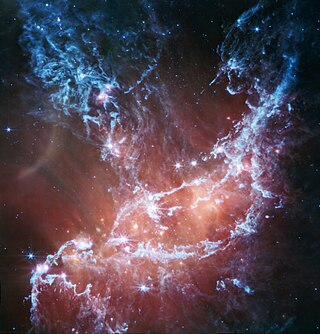
NGC 346 is a young open cluster of stars with associated nebula located in the Small Magellanic Cloud (SMC) that appears in the southern constellation of Tucana. It was discovered August 1, 1826 by Scottish astronomer James Dunlop. J. L. E. Dreyer described it as, "bright, large, very irregular figure, much brighter middle similar to double star, mottled but not resolved". On the outskirts of the cluster is the multiple star system HD 5980, one of the brightest stars in the SMC.

In astronomy, stellar kinematics is the observational study or measurement of the kinematics or motions of stars through space.

Cygnus OB2 is an OB association that is home to some of the most massive and most luminous stars known, including suspected Luminous blue variable Cyg OB2 #12. It also includes one of the largest known stars, NML Cygni. The region is embedded within a wider one of star formation known as Cygnus X, which is one of the most luminous objects in the sky at radio wavelengths. The region is approximately 1,570 parsecs from Earth in the constellation of Cygnus.
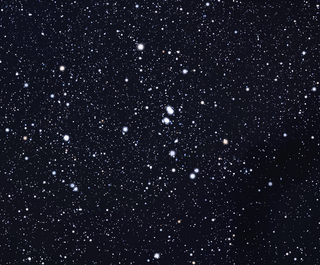
NGC 6871 is a small, young open cluster in the constellation of Cygnus. The cluster has fewer than 50 members, most of which are blue and white stars. It is located 5135 light-years from Earth.
HD 134687 is a binary star system in the southern constellation Lupus. It is visible to the naked eye with an apparent visual magnitude of 4.81. The distance to HD 134687 can be estimated from its annual parallax shift of 7.6 mas, yielding roughly 430 light years. It is a member of the ~11 million year old Upper Centaurus–Lupus subgroup of the Scorpius–Centaurus association, the closest OB association to the Sun.
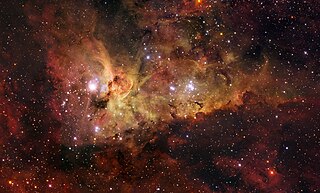
Trumpler 16 is a massive open cluster that is home to some of the most luminous stars in the Milky Way galaxy. It is situated within the Carina Nebula complex in the Carina–Sagittarius Arm, located approximately 9,270 ly (2,842 pc) from Earth. The cluster has one star visible to the naked eye from the tropics southward, Eta Carinae.
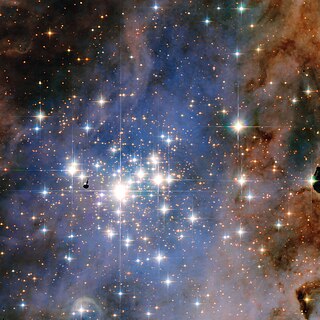
Trumpler 14 is an open cluster with a diameter of six light-years (1.8 pc), located within the inner regions of the Carina Nebula, approximately 8,980 light-years (2,753 pc) from Earth. Together with the nearby Trumpler 16, they are the main clusters of the Carina OB1 stellar association, which is the largest association in the Carina Nebula, although Trumpler 14 is not as massive or as large as Trumpler 16.

Trumpler 27 is a possible open cluster in the southern constellation Scorpius. If it exists, it is a few thousand light-years away from the Sun, with estimates ranging from 3,900 light-years to 6,800 light-years The name refers to Robert Julius Trumpler's catalog of open clusters, published in 1930.
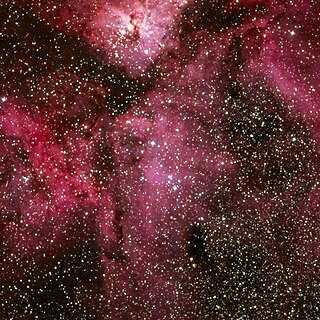
Collinder 228 is an open cluster within the southern part of the Carina Nebula NGC 3372, about 25' south of η Carinae. It is probably composed of stars which recently formed from the material in the nebula. QZ Carinae is the brightest member of Collinder 228 with an apparent magnitude between 6.16 and 6.49.
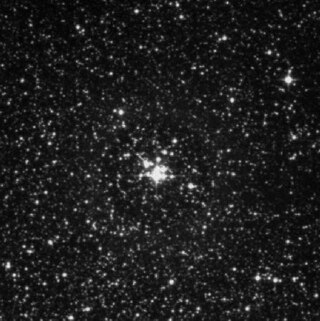
Pismis 20 is a compact open cluster in Circinus. It is located at the heart of the Circinus OB1 association in the Norma arm of the Milky Way Galaxy. Pismis 20 is about 3,270 pc away and only about 5 million years old. HD 134959, a blue supergiant variable star also called CX Circinus, is the brightest star in Pismis 20.
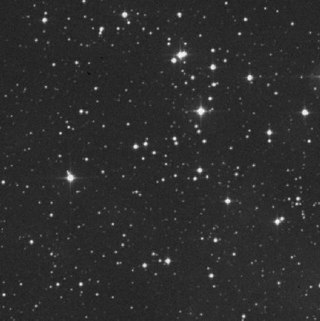
Berkeley 87 is an open cluster in a heavily obscured region of the Milky Way in Cygnus. The rare WO type Wolf–Rayet star WR 142 is a member of Berkeley 87.

Markarian 50 is an open cluster in the Milky Way galaxy. It is about 3,460 pc away in the constellation Cassiopeia. Markarian 50 is a very young open cluster, only about 7.5 million years old. Markarian 50 may be a member of the OB association Cassiopeia OB2. The Wolf-Rayet star WR 157 is a member of Markarian 50.














